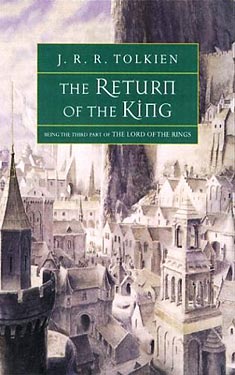JRR Tolkien
Completed 2/28/2015, Reviewed 3/4/2015
5 stars
What a ride this trip through “The Lord of the Rings” has
been. It rightly deserves its title of
the progenitor of the modern fantasy epic.
It took me through a full range of emotions, even leaving me weeping
uncontrollably at the end. Of course, I
mean the end of the story, not the end of the appendices. More about them later.
Again, this review contains spoilers, mostly because they
can’t be avoided in discussing some of the greater parts of the story.
 Frodo and Sam, sans Gollum, finally get into Mordor. The weight and temptation of the Ring becomes
overwhelming for Frodo. The two hobbits
barely have any hope left, but somehow they trudge on, circumventing the
numerous camps of orcs and men and traversing the hostile landscape to get to
Mount Doom. The rest of the fellowship
heads for Gondor, rallying towns, and even ghosts to aid them in the impending
attack of the Dark Lord on the White City.
Frodo and Sam, sans Gollum, finally get into Mordor. The weight and temptation of the Ring becomes
overwhelming for Frodo. The two hobbits
barely have any hope left, but somehow they trudge on, circumventing the
numerous camps of orcs and men and traversing the hostile landscape to get to
Mount Doom. The rest of the fellowship
heads for Gondor, rallying towns, and even ghosts to aid them in the impending
attack of the Dark Lord on the White City.
I feel like I’m always making reference to the films. Unfortunately, I think there isn’t any way to
avoid it as it is so ingrained in my head and part of my reading experience. So what I found myself marveling at most were
the chapters and scenes that weren’t in the films. The first time was in the chapter entitled “The
Houses of Healing”. It was beautiful and
powerful, conveying a holistic center of healing rather than an antiseptic
place of dying. Here, Aragorn reveals
himself as the king with the healing hands as he treats Faramir, Merry, and
Eowin with athelas, or kingsfoil, producing an overwhelming sense of the power
of goodness, like the aroma of the herb that invigorated all who smelled
it.
The other chapters I loved were those between the
destruction of the Ring and the Grey Havens.
I loved the detail of how everyone’s story came to conclusions. At first I thought it would drag on, but
instead, it felt very necessary and natural.
And The Scouring of the Shire is an amazing conclusion to the character
arcs of the hobbits. Not only was this
book about the ultimate battle between good and evil, but also about how the
four hobbits went from their quiet, pastoral existence to leaders in their own
right.
And now for the Appendices.
They are tough, particularly the first one. It reads like a college history book, rushing
through the lineage and major events of the Numenorian, Rohirran, and Dwarvish
kings, as well as the stewards of Gondor.
The only respite is the short piece about the relationship between
Aragorn and Arwin. It’s a gentle story
but all too short. I think the reason
that section is so nice is because you have a context for the two
characters. And despite her name in the
title, Arwin’s presence is still too small.
Her only actions of note is the making of a standard, an emblematic
banner, for Aragorn, and that she chooses to renounce immortality for a
man. You can see why in today’s context,
the female character arcs are archaic. Even
Eowyn’s plotline in the main story boils down to finding a man, despite having
a key role in the war for Gondor. It
makes me wonder how new first time readers perceive this.
While reading the rest of Appendix A, new names and their
actions are thrown at you, with no character development. All you know is what
you may (or more likely may not) remember from their brief references in the
story. This is what I fear in reading
The Silmarillion and the twelve volume history of Middle Earth series by
Tolkien’s son. Fortunately there are
some on-line seminars on the Silmarillion by an academic who calls himself the Tolkien
Professor to which I will probably listen to help me get through the heavy
history. It has come highly recommended
by some of the folks on worldswithoutend.com, and having any sort of discussion
on it will be a great help in understanding it.
The other appendices aren’t as difficult. I particularly like the discussion of the
alphabet and language, but I love reading about these topics. Linguistics and the history of language are
two of my “should haves”.
There is nothing like “The Lord of the Rings”. There are tons of other fantasy worlds out
there comprising trilogies and even longer series. Some of them are successful, even brilliant,
others not so much. And while the
appendices are tough, they add the weight of a complete universe that only a
few other writers have come close to developing. But there’s a purity and effortlessness about
LOTR that derives from Tolkien’s academic immersion in philology and ancient
northern European classic literature, and living through two world wars. It is the ultimate confrontation between good
and evil in a universe grounded in a living history. Five stars out of five.
No comments:
Post a Comment